Attractions · Europe · Going Out · Regions · Spain · Western Europe
Discover the Barcelona modernist route
Modernisme, or Catalan Modernism, came to Barcelona at the end of the 19th century. This architectural style, similar to the Art Nouveau movement, played a major role in indicating the social status of the then infamous bourgeoisie.
Rich clients used to employ well-known architects to design them a Modernista house, complete with the style’s recognisable features: rich sculptural and wrought iron work, stained glass, floral decorations, undulating forms, sgraffito work, and ceramic details.
Barcelona’s urban landscape is abundant in Modernisme creations, particularly in the Eixample neighbourhood, where these architectural gems often stand side by side. You simply need to walk around the city to understand just how important this cultural movement was to its inhabitants, and how Modernisme shaped Barcelona into the city that we know and love today.
The Barcelona Modernist Route
1. Park Güell
The Barcelona Modernist Route starts in the city’s Gràcia neighbourhood, just above the Eixample barrio, with Antoni Gaudí’s Park Güell. In 1899, Eusebi Güell first bought the land with the idea that his architect friend would design and create an urban park inspired by gardens in England. The finished creation has continued to charm its visitors ever since. The park is known for its Hansel and Gretel fairy-tale design, and stunning mosaic architectural details.
Antoni Gaudí played a huge part of bringing Modernism to life in Barcelona, and his short-term residence in Park Güell has since been converted into a museum with more information about the life and works of the incredible Catalan architect.
 2. Casa Vicens
Further down from Park Güell, still in Gràcia, is Gaudí’s first project of importance, Casa Vicens. The Catalan architect built this sensational house just after he obtained his architectural license in 1878, and many think that Casa Vicens was the first great work of Catalan modernisme. Although the Gràcia neighbourhood is now part of Barcelona city, it was previously a separate village, independent and with its own city council. Many rich bourgeoisie aristocrats took a liking to the barrio, like Manel Vicens i Montaner, for whom this house was built. More than 150 years later, Casa Vicens has been opened up to the public as a house museum, rich in Modernist design and history from this bygone era.
2. Casa Vicens
Further down from Park Güell, still in Gràcia, is Gaudí’s first project of importance, Casa Vicens. The Catalan architect built this sensational house just after he obtained his architectural license in 1878, and many think that Casa Vicens was the first great work of Catalan modernisme. Although the Gràcia neighbourhood is now part of Barcelona city, it was previously a separate village, independent and with its own city council. Many rich bourgeoisie aristocrats took a liking to the barrio, like Manel Vicens i Montaner, for whom this house was built. More than 150 years later, Casa Vicens has been opened up to the public as a house museum, rich in Modernist design and history from this bygone era.
 3. Hospital de la Santa Creu i Sant Pau
After leaving Gràcia and entering Eixample, the route continues to the Hospital de la Santa Creu i Sant Pau, the oldest hospital in Spain founded in 1401. The hospital was created as a result of six of the city’s medieval hospitals merging together to combat Plague and famine. In 1930, the hospital closed its doors for a complete redesign; one of the last patients treated inside was Antoni Gaudí himself, fatally injured from a tram accident in 1926.
The architect in question chosen for this redesign was Lluís Domènech i Montaner, previously known for his other Modernist architectural feats. In time, the hospital became the first in Spain to have its own school of nursing, to enforce an institutional charter of patient rights (1976), to launch a customer care service (1979), and to offer bone marrow transplants (1976) and heart transplants (1984). Today, it is an essential modernist landmark in Barcelona.
3. Hospital de la Santa Creu i Sant Pau
After leaving Gràcia and entering Eixample, the route continues to the Hospital de la Santa Creu i Sant Pau, the oldest hospital in Spain founded in 1401. The hospital was created as a result of six of the city’s medieval hospitals merging together to combat Plague and famine. In 1930, the hospital closed its doors for a complete redesign; one of the last patients treated inside was Antoni Gaudí himself, fatally injured from a tram accident in 1926.
The architect in question chosen for this redesign was Lluís Domènech i Montaner, previously known for his other Modernist architectural feats. In time, the hospital became the first in Spain to have its own school of nursing, to enforce an institutional charter of patient rights (1976), to launch a customer care service (1979), and to offer bone marrow transplants (1976) and heart transplants (1984). Today, it is an essential modernist landmark in Barcelona.
 4. La Pedrera/Casa Milá
The Modernist route then crosses through Eixample and over Avinguda Diagonal, one of Barcelona’s most important main roads, to La Pedrera (or Casa Milá), the last private residence designed by Antoni Gaudí before he devoted himself to his extraordinary project of building the Sagrada Família. Intent on having their own Modernista residence, Pere Milà and his wife Roser Segimon commissioned Antoni Gaudí to build them a house incorporating this style in 1906. At the time, this construction was a controversial topic among those living in Barcelona due to the house’s garish stone façade, and as a result, the structure earned itself the nickname La Pedrera, or the “stone quarry”. In 1984, Casa Milà was declared a UNESCO World Heritage Site, and today it is one of the most visited tourist attractions in the city.
4. La Pedrera/Casa Milá
The Modernist route then crosses through Eixample and over Avinguda Diagonal, one of Barcelona’s most important main roads, to La Pedrera (or Casa Milá), the last private residence designed by Antoni Gaudí before he devoted himself to his extraordinary project of building the Sagrada Família. Intent on having their own Modernista residence, Pere Milà and his wife Roser Segimon commissioned Antoni Gaudí to build them a house incorporating this style in 1906. At the time, this construction was a controversial topic among those living in Barcelona due to the house’s garish stone façade, and as a result, the structure earned itself the nickname La Pedrera, or the “stone quarry”. In 1984, Casa Milà was declared a UNESCO World Heritage Site, and today it is one of the most visited tourist attractions in the city.
 5. Casa Batlló
A short walk down the city’s most iconic avenue, Passeig de Gràcia, is Casa Batlló: another of Antoni Gaudí’s most stunning architectural feats. This landmark is sometimes referred to as Casa dels Ossos (House of Bones) due to the somewhat skeletal qualities in its design. Casa Batlló was first built in 1877, and then redesigned in 1904 after its owner, Josep Batlló, wanted a unique house that no other family member would be able to imitate. On special days in Catalonia, such as Sant Jordi in April, Casa Batlló is often decorated to mark the event. Last year the façade of the building was covered in hundreds of red roses to mark the celebration of Catalonia’s patron saint.
5. Casa Batlló
A short walk down the city’s most iconic avenue, Passeig de Gràcia, is Casa Batlló: another of Antoni Gaudí’s most stunning architectural feats. This landmark is sometimes referred to as Casa dels Ossos (House of Bones) due to the somewhat skeletal qualities in its design. Casa Batlló was first built in 1877, and then redesigned in 1904 after its owner, Josep Batlló, wanted a unique house that no other family member would be able to imitate. On special days in Catalonia, such as Sant Jordi in April, Casa Batlló is often decorated to mark the event. Last year the façade of the building was covered in hundreds of red roses to mark the celebration of Catalonia’s patron saint.
 6. Casa Amatller
The next modernista landmark on the route is Casa Amatller, the next-door neighbour of Casa Batlló. Under the commission of famous chocolatier Antoni Amatller Costa, the building was designed by Josep Puig i Cadafalch, another famous Catalan architect from the Modernisme era. As well as some key Modernista design aspects, Casa Amatller also incorporates Germanic and neo-Gothic elements. These days, visitors can only visit the ground floor of the building, home to one of the finest stained-glass windows of the modernisme era, as well as a café that serves drinking chocolate using the century old original Amatller recipe.
6. Casa Amatller
The next modernista landmark on the route is Casa Amatller, the next-door neighbour of Casa Batlló. Under the commission of famous chocolatier Antoni Amatller Costa, the building was designed by Josep Puig i Cadafalch, another famous Catalan architect from the Modernisme era. As well as some key Modernista design aspects, Casa Amatller also incorporates Germanic and neo-Gothic elements. These days, visitors can only visit the ground floor of the building, home to one of the finest stained-glass windows of the modernisme era, as well as a café that serves drinking chocolate using the century old original Amatller recipe.
 7. Palau de la Música Catalana
The Barcelona Modernist Route finishes with the Palau de la Música Catalana concert hall. This spectacular performance space was designed by Lluís Domenech i Montaner, known mostly for his work on the Sant Pau Hospital redesign. It was created upon the order of the Catalan choral society, and on its completion in 1908, the building was inaugurated as an auditorium for concerts of orchestral and instrumental music. Over the years, this concert hall has seen some of best international artists from all over the world perform on its stage and has since become one of the most representative buildings of Catalan modernism.
7. Palau de la Música Catalana
The Barcelona Modernist Route finishes with the Palau de la Música Catalana concert hall. This spectacular performance space was designed by Lluís Domenech i Montaner, known mostly for his work on the Sant Pau Hospital redesign. It was created upon the order of the Catalan choral society, and on its completion in 1908, the building was inaugurated as an auditorium for concerts of orchestral and instrumental music. Over the years, this concert hall has seen some of best international artists from all over the world perform on its stage and has since become one of the most representative buildings of Catalan modernism.
 Sandra Roig is Marketing Director at AB Apartment Barcelona. AB Apartment Barcelona is an apartment rental agency offering over one thousand short and long term apartments across Barcelona.
If you would like to be a guest blogger on A Luxury Travel Blogin order to raise your profile, please contact us.
Sandra Roig is Marketing Director at AB Apartment Barcelona. AB Apartment Barcelona is an apartment rental agency offering over one thousand short and long term apartments across Barcelona.
If you would like to be a guest blogger on A Luxury Travel Blogin order to raise your profile, please contact us.
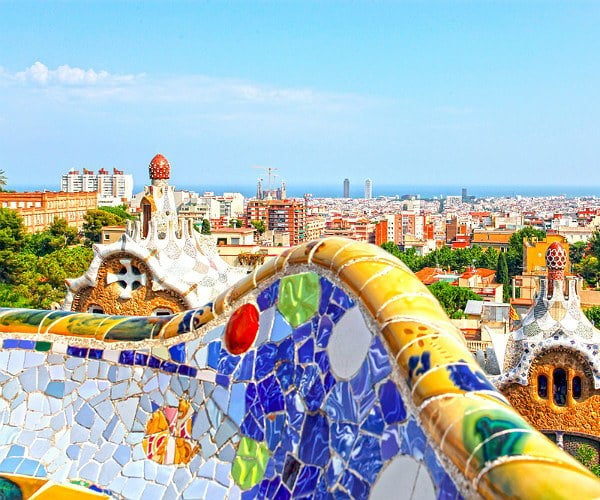 2. Casa Vicens
Further down from Park Güell, still in Gràcia, is Gaudí’s first project of importance, Casa Vicens. The Catalan architect built this sensational house just after he obtained his architectural license in 1878, and many think that Casa Vicens was the first great work of Catalan modernisme. Although the Gràcia neighbourhood is now part of Barcelona city, it was previously a separate village, independent and with its own city council. Many rich bourgeoisie aristocrats took a liking to the barrio, like Manel Vicens i Montaner, for whom this house was built. More than 150 years later, Casa Vicens has been opened up to the public as a house museum, rich in Modernist design and history from this bygone era.
2. Casa Vicens
Further down from Park Güell, still in Gràcia, is Gaudí’s first project of importance, Casa Vicens. The Catalan architect built this sensational house just after he obtained his architectural license in 1878, and many think that Casa Vicens was the first great work of Catalan modernisme. Although the Gràcia neighbourhood is now part of Barcelona city, it was previously a separate village, independent and with its own city council. Many rich bourgeoisie aristocrats took a liking to the barrio, like Manel Vicens i Montaner, for whom this house was built. More than 150 years later, Casa Vicens has been opened up to the public as a house museum, rich in Modernist design and history from this bygone era.
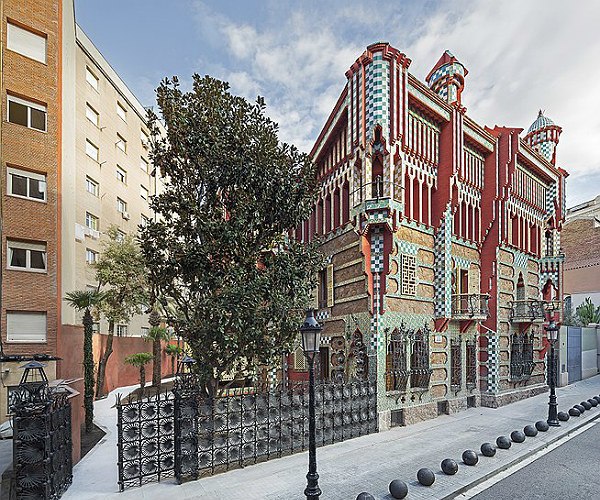 3. Hospital de la Santa Creu i Sant Pau
After leaving Gràcia and entering Eixample, the route continues to the Hospital de la Santa Creu i Sant Pau, the oldest hospital in Spain founded in 1401. The hospital was created as a result of six of the city’s medieval hospitals merging together to combat Plague and famine. In 1930, the hospital closed its doors for a complete redesign; one of the last patients treated inside was Antoni Gaudí himself, fatally injured from a tram accident in 1926.
The architect in question chosen for this redesign was Lluís Domènech i Montaner, previously known for his other Modernist architectural feats. In time, the hospital became the first in Spain to have its own school of nursing, to enforce an institutional charter of patient rights (1976), to launch a customer care service (1979), and to offer bone marrow transplants (1976) and heart transplants (1984). Today, it is an essential modernist landmark in Barcelona.
3. Hospital de la Santa Creu i Sant Pau
After leaving Gràcia and entering Eixample, the route continues to the Hospital de la Santa Creu i Sant Pau, the oldest hospital in Spain founded in 1401. The hospital was created as a result of six of the city’s medieval hospitals merging together to combat Plague and famine. In 1930, the hospital closed its doors for a complete redesign; one of the last patients treated inside was Antoni Gaudí himself, fatally injured from a tram accident in 1926.
The architect in question chosen for this redesign was Lluís Domènech i Montaner, previously known for his other Modernist architectural feats. In time, the hospital became the first in Spain to have its own school of nursing, to enforce an institutional charter of patient rights (1976), to launch a customer care service (1979), and to offer bone marrow transplants (1976) and heart transplants (1984). Today, it is an essential modernist landmark in Barcelona.
 4. La Pedrera/Casa Milá
The Modernist route then crosses through Eixample and over Avinguda Diagonal, one of Barcelona’s most important main roads, to La Pedrera (or Casa Milá), the last private residence designed by Antoni Gaudí before he devoted himself to his extraordinary project of building the Sagrada Família. Intent on having their own Modernista residence, Pere Milà and his wife Roser Segimon commissioned Antoni Gaudí to build them a house incorporating this style in 1906. At the time, this construction was a controversial topic among those living in Barcelona due to the house’s garish stone façade, and as a result, the structure earned itself the nickname La Pedrera, or the “stone quarry”. In 1984, Casa Milà was declared a UNESCO World Heritage Site, and today it is one of the most visited tourist attractions in the city.
4. La Pedrera/Casa Milá
The Modernist route then crosses through Eixample and over Avinguda Diagonal, one of Barcelona’s most important main roads, to La Pedrera (or Casa Milá), the last private residence designed by Antoni Gaudí before he devoted himself to his extraordinary project of building the Sagrada Família. Intent on having their own Modernista residence, Pere Milà and his wife Roser Segimon commissioned Antoni Gaudí to build them a house incorporating this style in 1906. At the time, this construction was a controversial topic among those living in Barcelona due to the house’s garish stone façade, and as a result, the structure earned itself the nickname La Pedrera, or the “stone quarry”. In 1984, Casa Milà was declared a UNESCO World Heritage Site, and today it is one of the most visited tourist attractions in the city.
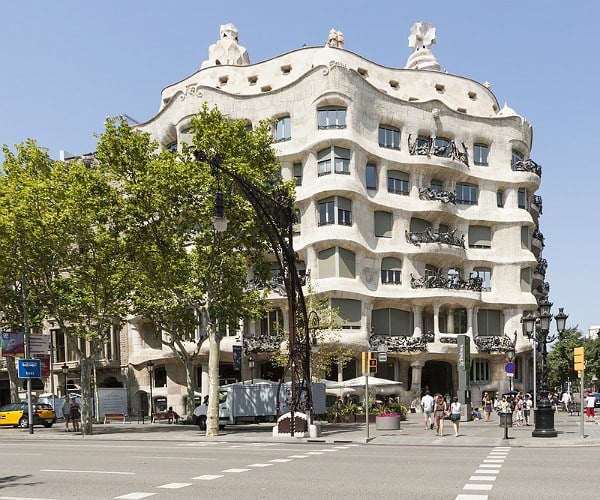 5. Casa Batlló
A short walk down the city’s most iconic avenue, Passeig de Gràcia, is Casa Batlló: another of Antoni Gaudí’s most stunning architectural feats. This landmark is sometimes referred to as Casa dels Ossos (House of Bones) due to the somewhat skeletal qualities in its design. Casa Batlló was first built in 1877, and then redesigned in 1904 after its owner, Josep Batlló, wanted a unique house that no other family member would be able to imitate. On special days in Catalonia, such as Sant Jordi in April, Casa Batlló is often decorated to mark the event. Last year the façade of the building was covered in hundreds of red roses to mark the celebration of Catalonia’s patron saint.
5. Casa Batlló
A short walk down the city’s most iconic avenue, Passeig de Gràcia, is Casa Batlló: another of Antoni Gaudí’s most stunning architectural feats. This landmark is sometimes referred to as Casa dels Ossos (House of Bones) due to the somewhat skeletal qualities in its design. Casa Batlló was first built in 1877, and then redesigned in 1904 after its owner, Josep Batlló, wanted a unique house that no other family member would be able to imitate. On special days in Catalonia, such as Sant Jordi in April, Casa Batlló is often decorated to mark the event. Last year the façade of the building was covered in hundreds of red roses to mark the celebration of Catalonia’s patron saint.
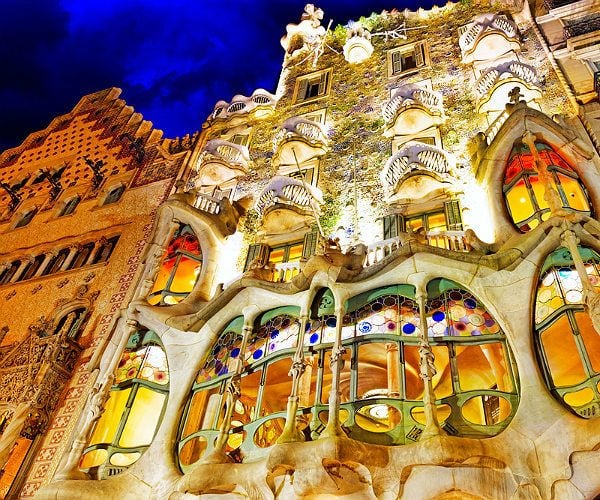 6. Casa Amatller
The next modernista landmark on the route is Casa Amatller, the next-door neighbour of Casa Batlló. Under the commission of famous chocolatier Antoni Amatller Costa, the building was designed by Josep Puig i Cadafalch, another famous Catalan architect from the Modernisme era. As well as some key Modernista design aspects, Casa Amatller also incorporates Germanic and neo-Gothic elements. These days, visitors can only visit the ground floor of the building, home to one of the finest stained-glass windows of the modernisme era, as well as a café that serves drinking chocolate using the century old original Amatller recipe.
6. Casa Amatller
The next modernista landmark on the route is Casa Amatller, the next-door neighbour of Casa Batlló. Under the commission of famous chocolatier Antoni Amatller Costa, the building was designed by Josep Puig i Cadafalch, another famous Catalan architect from the Modernisme era. As well as some key Modernista design aspects, Casa Amatller also incorporates Germanic and neo-Gothic elements. These days, visitors can only visit the ground floor of the building, home to one of the finest stained-glass windows of the modernisme era, as well as a café that serves drinking chocolate using the century old original Amatller recipe.
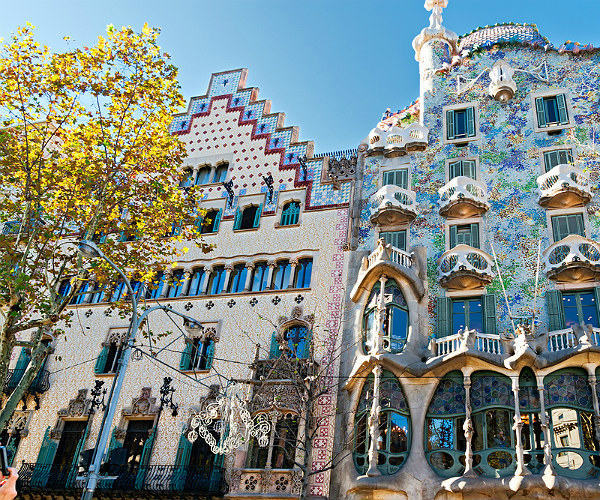 7. Palau de la Música Catalana
The Barcelona Modernist Route finishes with the Palau de la Música Catalana concert hall. This spectacular performance space was designed by Lluís Domenech i Montaner, known mostly for his work on the Sant Pau Hospital redesign. It was created upon the order of the Catalan choral society, and on its completion in 1908, the building was inaugurated as an auditorium for concerts of orchestral and instrumental music. Over the years, this concert hall has seen some of best international artists from all over the world perform on its stage and has since become one of the most representative buildings of Catalan modernism.
7. Palau de la Música Catalana
The Barcelona Modernist Route finishes with the Palau de la Música Catalana concert hall. This spectacular performance space was designed by Lluís Domenech i Montaner, known mostly for his work on the Sant Pau Hospital redesign. It was created upon the order of the Catalan choral society, and on its completion in 1908, the building was inaugurated as an auditorium for concerts of orchestral and instrumental music. Over the years, this concert hall has seen some of best international artists from all over the world perform on its stage and has since become one of the most representative buildings of Catalan modernism.
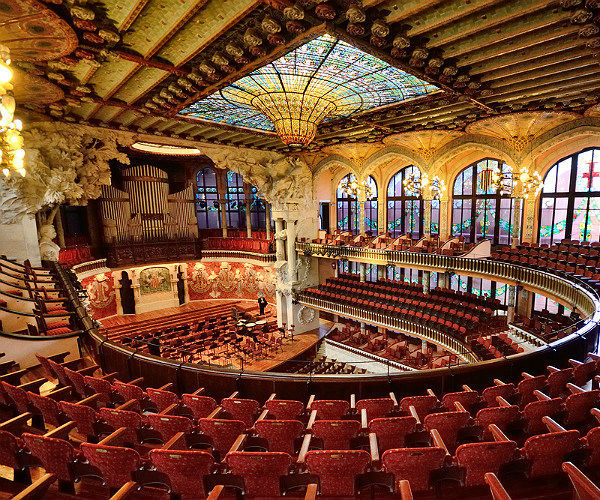 Sandra Roig is Marketing Director at AB Apartment Barcelona. AB Apartment Barcelona is an apartment rental agency offering over one thousand short and long term apartments across Barcelona.
If you would like to be a guest blogger on A Luxury Travel Blogin order to raise your profile, please contact us.
Sandra Roig is Marketing Director at AB Apartment Barcelona. AB Apartment Barcelona is an apartment rental agency offering over one thousand short and long term apartments across Barcelona.
If you would like to be a guest blogger on A Luxury Travel Blogin order to raise your profile, please contact us.Did you enjoy this article?
Receive similar content direct to your inbox.



You mention the Sagrada Familia. How is progress getting on? When I first visited in the 1980s I doubted that it would be completed in my lifetime but last time I called in, perhaps five years ago, things were looking up. Although I am not a Catholic, taking part in a service at a fully completed Sagrada Familia is on my bucket-list.
Hi Elizabeth, thanks for your question. We hope that the Sagrada Familia will be finished in 2026, the year which also marks the centenary year of Gaudi’s death. One of our marketing team actually went to a mass a few weeks ago, and she said it was incredible, even in the unfinished church. We would definitely recommend doing this and also coming back to see the church finished in 2026 as well!
Thanks for the update. There will be some great celebrations when it’s finally complete. I expect Barcelona will be packed that year. A lot of us having been waiting a long time for the finished article.
One of the best things about Barcelona it that you can briefly escape from the crowds and succession of global brands. One minute you are walking past the shop windows and global logos that you would see in many cities of the world then suddenly you see a sight as wonderful as the Casa Milan or Casa Batiilo. It is seeing such original architectural creations like these which makes Barcelona such a rich treat for the eye.
Hi Gerald, you’re bang on there! The recent tourism growth really has turned the city into an eclectic mix of old and new. But we like to think that our beloved Barcelona has stood the test of time, and is still as lovely as before!
Great post.
Calling all A Luxury Travel Bloggers – could we have more pieces like this on the cities of the world please?
As time goes on I get more and more interested in what architecture tells us about a place and it’s people.
Hi Darius, thanks for your comment, we are ecstatic that you loved our post. Do let us know if you end up doing the Barcelona Modernist Route the next time that you’re in the city!
I like the idea of hot chocolate at Casa Amatller. Any where else along the route for watering holes and refuelling? Walking round this modernist route is thirsty work. Got any recommendations for churros or tapas overlooking some Modernist masterpieces. Or anywhere for a classic paella with a view?
In my humble opinion Barcelona would be half the city that it is today without Gaudi’s creative contribution. I know that people will claim that Barcelona has got plenty of other things going for it but it would have far less beauty and character without Gaudi.
It’s fascinating to learn a bit more about how Modernism made its way to Barcelona, and to see such distinctive designs and architecture. It’s very poetic that the last patient treated at the Hospital de la Santa Creu before it closed for a refurbishment was Antoni Guadi. This is actually the first time I’ve learned about the history of the hospital, and I had no idea it had such a pivotal role in changing medical care in Spain.
I can’t believe there is a place where art can be seen anywhere you look around. I’ve been to Barcelona countless times now and the sceneries still make my jaw drop. I love how they apply the movement in any place they can think of. Modernism is a very unique form of art and it takes a lot of skill and creativity. Hands down to these artists who made the place look like it was out of a painting. Gaudi definitely deserves all the praises.
There’s so much diversity in these choices. The Palau de la Música Catalana is truly something to behold. It reminds me of a grandiose movie background or something you might find in an old Shakespeare play. I’d love to check that out sometime.